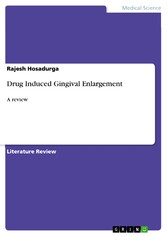Suchen und Finden
Service
Drug Induced Gingival Enlargement - A review
Rajesh Hosadurga
Verlag GRIN Verlag , 2013
ISBN 9783656444039 , 73 Seiten
Format PDF
Kopierschutz frei
Geräte
Literature Review from the year 2005 in the subject Medicine - Dentistry, Rajiv Gandhi University (Yenepoya Dental college), course: Master of Dental Surgery, language: English, abstract: Increase in the size of the gingiva is a common feature of gingival disease. Accepted current terminology for this condition is gingival enlargement and gingival overgrowth. These are strictly clinical descriptive terms and avoid the erroneous pathologic connotations of terms used in the past such as hypertrophic gingivitis or gingival hyperplasia. The gingiva and associated soft tissues of the periodontium may be enlarged in response to various interactions between the host and the environment. Although such enlargement usually represents an inflammatory response to bacterial plaque, increased susceptibility as a result of systemic factors or conditions should always be considered during the course of patient evaluation. Systemically related gingival enlargements include, but are not limited to, scurvy, leukemia, puberty, pregnancy, multisystem syndromes and selected drugs and/or agents. In addition, fibrotic gingival enlargement has been reported and is believed to be the result of a genetic predisposition (for example hereditary or familial gingival enlargement). However an idiopathic variant that has not been associated with genetic linkage or cause has been described. Of the predisposing factors associated with the gingival enlargement, selected anticonvulsant drug, Calcium channel blockers and a potent immunosuppressant (Cyclosporine A) have generated the most investigative attention in the scientific community. Since the first report of Phenytoin induced gingival overgrowth by Kimball in 1939, many clinical and investigative studies have been carried out to determine the pathogenesis of this disorder. Although these studies yielded various pathogenetic data, it is still unknown why drugs with such different pharmacological actions induce similar gingival changes. Furthermore different views concerning the interrelationships between blood drug levels and/or duration of drug intake and the severity of growth, sex predilection, effect of local inflammation and incidence has been reported in the literature. The genetically determined capacity of the host to deal metabolically with chronically administered drugs; the responsiveness of gingival tissues to the drugs and the pre-existing gingival condition may differ among individuals.
Service
Shop



